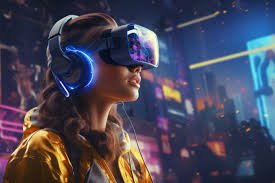The Growth of Augmented Reality (AR) Applications: Transformations in Entertainment, Education, and Retail in 2024
Introduction: Augmented Reality’s Expanding Horizons
Augmented Reality (AR) has moved beyond its initial applications and is now making a significant impact across various sectors. In 2024, AR technology is experiencing rapid growth and transformation, reshaping how we interact with the world in entertainment, education, and retail. As AR applications become more advanced and accessible, they are offering immersive experiences and practical solutions that enhance everyday activities.
Transformations in Entertainment
1. Immersive Gaming Experiences
In the entertainment sector, AR is revolutionizing gaming with immersive and interactive experiences. Pokémon GO, which popularized AR gaming, has evolved with new features and updates, maintaining its relevance in 2024. Niantic, the company behind Pokémon GO, has continued to innovate with AR experiences that blend the virtual and real worlds in more interactive ways. For example, new AR games now incorporate location-based challenges and social features that enhance player engagement and interaction.
2. Enhanced Live Events and Performances
AR technology is also transforming live events and performances. Concerts and theater productions are incorporating AR elements to create visually stunning experiences that engage audiences in novel ways. For instance, artists like Beyoncé and Coldplay are using AR to project immersive visuals and interactive content during their live shows. This technology allows performers to enhance their stage presence and create memorable experiences for their audiences.
3. Interactive Media and Storytelling
AR is expanding the possibilities of interactive media and storytelling. AR-based apps like Stories by Google and AR Journal are providing users with dynamic and immersive ways to experience narratives. These apps use AR to overlay digital content onto physical environments, allowing users to interact with stories in a more engaging and participatory manner. This transformation is pushing the boundaries of traditional media and storytelling formats.
Advancements in Education
1. Engaging Learning Experiences
In education, AR is creating engaging and interactive learning experiences that enhance student comprehension and retention. AR applications like Google Expeditions and Zspace are being used to bring complex concepts to life. For example, students can explore historical events, scientific phenomena, and anatomical structures through interactive 3D models and simulations. These immersive experiences help students grasp abstract concepts and foster a deeper understanding of the subject matter.
2. Remote Learning and Virtual Classrooms
The growth of AR technology is also supporting remote learning and virtual classrooms. AR-enabled educational tools allow students to participate in interactive lessons and collaborate with peers in virtual environments. Platforms like ClassVR and ARIS offer virtual field trips, interactive simulations, and collaborative projects that enhance the remote learning experience. These tools help bridge the gap between traditional in-person education and modern digital learning methods.
3. Skill Development and Training
AR is being used for skill development and vocational training across various industries. Medical training programs, for instance, utilize AR to simulate surgical procedures and medical scenarios, providing hands-on practice in a controlled environment. Corporate training programs also leverage AR to offer interactive and realistic training experiences, helping employees develop new skills and improve job performance.
Innovations in Retail
1. Virtual Try-Ons and Shopping
In retail, AR is revolutionizing the shopping experience by enabling virtual try-ons and product visualizations. Retailers like L’Oréal and Nike have integrated AR technology into their apps and websites, allowing customers to virtually try on cosmetics, apparel, and accessories. This feature not only enhances the shopping experience but also helps reduce return rates by allowing customers to make more informed purchasing decisions.
2. Interactive Store Displays
AR technology is also transforming physical retail environments with interactive store displays. IKEA Place and Home Depot use AR to allow customers to visualize how furniture and home improvement products will look in their own homes. These interactive displays provide a more engaging and personalized shopping experience, helping customers make better purchasing decisions.
3. Enhanced Customer Engagement
Retailers are using AR to enhance customer engagement through interactive promotions and marketing campaigns. Sephora, for example, has implemented AR in its stores to offer personalized product recommendations and virtual beauty consultations. These AR experiences create a more immersive and interactive shopping environment, fostering deeper connections with customers.
Conclusion: The Expanding Impact of AR
In conclusion, the growth of Augmented Reality (AR) applications in 2024 is transforming entertainment, education, and retail in profound ways. From immersive gaming experiences and interactive media to engaging learning tools and innovative retail solutions, AR technology is reshaping how we interact




